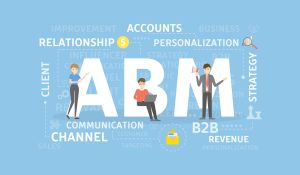
Account-based marketing (ABM) is a B2B marketing strategy that targets specific high-value accounts rather than a broader audience. ABM is a highly personalized and targeted approach that involves tailoring marketing efforts and messaging to particular accounts or individuals within those accounts. ABM has become increasingly popular among B2B marketers because it drives higher ROI, improves sales alignment, and increases customer retention.
Our previous blog discussed the basics, like definition, importance, functionality, and other insights on ABM. This article will delve deeper into the world of ABM, focusing on effective B2B account-based marketing solutions. We will explore the different types of ABM and provide implementation frameworks and strategies for executing successful ABM campaigns.
Varied Types of B2B Account-based Marketing
B2B marketers have established three separate forms of account-based marketing, and businesses are attempting to develop programs and skills in all three types.
In an ideal scenario, the various forms of B2B account-based marketing correspond directly with the growth potential and sales coverage for multiple types and tiers of existing customers and prospects. Let’s get into their specifics.
1. One-to-one Account-based Marketing
A senior-level marketer collaborates closely with the account team to develop highly tailored marketing plans for “one-to-one” markets.
2. One-to-few Account-based Marketing
It applies the research based on One-to-One concepts to target bigger audiences of groups of accounts. This strategy often groups 5 to 15 clients with similar business concerns, frequently within the same industry.
3. One-to-many Account-based Marketing
It emphasizes large-scale customization. This strategy often targets a list of several hundred (or more) identified accounts selected deliberately. To reach this degree of scalability, technology must play a crucial role.
Definitive Account-Based Marketing Framework
B2B account-based marketing differs from the conventional sales funnel. Even though ABM may be applied across sectors and business types, a fundamental structure must be followed to ensure its efficacy. Here are the fundamental components of a framework for account-based marketing.
1. Marketing-sales Alignment
The significance of the collaboration between sales and marketing departments cannot be stressed enough. Marketing and sales must be on the same page to have a comprehensive B2B Account based marketing strategy and guarantee that target accounts enjoy an engaging buying experience.
2. Account Qualification
A fundamental component of a high-value account and an ABM framework is the creation of an ICP for the accounts your organization wants to pursue. It is also important to note that marketing and sales should participate in these discussions.
Consider the following considerations while qualifying a potential client:
- Financials
- Scalability
- Competitive landscape
3. Go-to-market Approach
Once marketing and sales align on approach and target accounts, it is time to develop a go-to-market strategy.
Also Read: Account-Based Marketing Handbook
Using an ABM technique, comprehend how a new customer would go through the sales process. Due to the importance of a tailored experience in account-based marketing, your team will also need to seek new methods to offer value and provide a premium experience to these accounts.
How Do We Create an Account-based Marketing Strategy?
ABM tactics act as building blocks of your strategy. Here is a list to ensure your ABM efforts and investment are successful.
- Use a strategic account planning template
- Ensure organizational ABM alignment
- Build your ABM team
- Encourage Marketing and Sales to develop account plans jointly
1. Use a strategic account planning template
Several available free templates can assist you in outlining your efforts for each account.
2. Ensure organizational ABM alignment
Ensure all internal stakeholders are on board with the different account-based marketing plan components. This will enable businesses to be on their toes and make it simpler to offer uniform experiences for accounts. Nonetheless, ensure that your method is as effective and concise as feasible.
3. Build your ABM team
Build an account-based marketing (ABM) team by choosing one marketer and one salesperson who will be entirely committed to the accounts you serve. However, in addition to marketers and sales representatives, remember to select customer success representatives.
4. Encourage marketing and sales to develop account plans jointly
Ensure the participation of the right marketing and sales team members in account planning.
Here are some other techniques marketing and sales may utilize to create successful account plans:
- Integrate your various sales and marketing programs to guarantee that all ABM applications are in sync.
- Ensure marketing and sales are aligned on the value proposition and point of differentiation for each account for your product or service.
- Create personalized material or change current content to be specific to each account.
- Tailor your budget and assign resources for each account.
5. Attract contacts from high-quality accounts
Personalize content to high-quality accounts, which in turn will help you elevate brand awareness and maximize relevance among audience members.
Some GDPR-compliant recommendations for attracting high-quality accounts:
- Engage accounts on social media
- Host a podcast or video series with an account leader
- Sponsor a target account conference or event booth
- Communicate through LinkedIn InMail outreach
- Ask current contacts, accounts, and customers for referrals
Benefits of Account-based Marketing
Account-based Marketing (ABM) is a strategic approach to B2B marketing that focuses on targeted engagement with specific accounts rather than a broad-based, one-size-fits-all approach. There are numerous benefits of b2b account-based marketing to businesses, including:
1. Increased Efficiency:
ABM allows you to focus your marketing efforts on the accounts that matter most, reducing waste and increasing efficiency.
2. Better Targeting:
ABM will enable you to build hyper-targeted campaigns that resonate with your ideal customers.
3. Improved Relationships:
ABM helps build stronger relationships with your target accounts by taking a personalized marketing approach.
4. Increased Revenue:
ABM has been proven to drive larger deal sizes and close rates than traditional, broad-based marketing tactics.
5. Data-driven Insights:
ABM provides valuable data and insights into the behaviors and preferences of your target accounts, allowing you to optimize your marketing efforts over time.
6. Consistent customer experiences:
ABM connects sales and marketing to achieve a single objective. Each customer should feel like they are the only market for your business. With the help of customizations, ABM helps deliver consistent consumer experiences.
Also Read: The Art of ABM: A Strategic Guide to Account-Based Marketing
Overall, ABM enables businesses to focus their marketing efforts on the accounts that matter most, resulting in higher ROI and more successful sales outcomes.
Account-Based Marketing Examples
Account-Based Marketing (ABM) is a targeted approach to B2B marketing that focuses on engaging with specific, high-value accounts. Here are a few examples of ABM in action:
1. Personalized Websites
ABM campaigns on the web are not limited to generating visitors via customized SEM and inbound marketing strategies. Creating personalized websites or landing pages for each target account tailored to their specific needs and interests.
2. Direct Mail
Sending targeted direct mail pieces, such as a customized brochure or a sample product, to key decision makers at target accounts. Since ABM is more focused, direct mail gifts and marketing may be of greater value, as the income potential is significantly greater.
3. Account-based Advertising
Running targeted digital ads, such as display or social media ads, to reach decision-makers at target accounts.
4. Event Invitations
An account-based marketing strategy for events may include individualized invites to important prospects from target accounts, exclusive VIP dinners, bespoke gifts for target accounts, and personalized post-event follow-up. Inviting target accounts to attend a customized event, such as a dinner or a product demo, specifically tailored to their interests.
5. Account-based Content
Creating and sharing targeted content, such as whitepapers, case studies, or webinars, to engage with target accounts and build thought leadership.
6. Sales and Marketing Alignment
Closely aligning sales and marketing efforts, with sales reps acting as ambassadors for marketing campaigns and vice versa.
These are just a few examples of account-based marketing best practices, and the specific approach that’s right for your business will depend on your target accounts, goals, and resources. The key to successful ABM is to take a targeted, personalized approach to engage with your target accounts and to measure and optimize your efforts over time.
Account-Based Marketing Challenges
Account-based marketing strategy is a targeted approach to B2B marketing, but like any marketing strategy, it also has its challenges. Some of the common challenges associated with ABM include the following:
1. Data Management
ABM requires accurate and up-to-date account data, which can be challenging to manage and maintain.
2. Integration
ABM requires close collaboration between sales and marketing teams and integration with other marketing technology systems.
3. Cost
ABM can be expensive to implement, especially for smaller businesses.
4. Measurement and ROI
Measuring the success of ABM can be difficult, and it can be challenging to quantify the ROI of ABM efforts.
5. Account Selection
Selecting the right accounts to target can be complex and time-consuming, requiring careful consideration of account fit, budget, and other factors.
6. Alignment
ABM requires close alignment between sales and marketing teams and clear communication of goals and expectations.
Despite these challenges, many businesses have found ABM to be a highly effective approach to B2B marketing, delivering better results and higher ROI than traditional, broad-based marketing tactics. To overcome these challenges, having a well-defined account-based marketing strategy and investing in the right tools and resources to support your efforts is important.
Wrap Up
In conclusion, account-based marketing is a targeted approach to B2B marketing that has gained widespread popularity in recent years. B2B account-based marketing has delivered higher ROI and more successful sales outcomes than traditional, broad-based marketing tactics.
ABM also offers several benefits; however, it also presents some challenges. To overcome these challenges and succeed with ABM, it’s important to have a well-defined ABM strategy, invest in the right tools and resources, and closely align sales and marketing efforts.
The Binary Demand team can also help you overcome these challenges with expertise and grow your business substantially.








